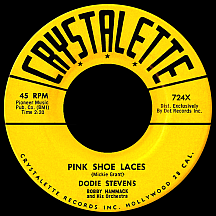DODIE STEVENS
Pink Shoe Laces
The song itself is undeniably juvenile, yet the singer sounds mature. Still, the lyrics give it away as something less than serious. When Mickie Grant wrote 'I've got a guy and his name is Dooley, he's my guy and I love him truly...he's not good lookin', heaven knows, but I'm wild about his crazy clothes!' it marked the second time in the space of a few months that a guy with that name popped up in a popular song. The Kingston Trio had taken a story about the hanging of a condemned man named "Tom Dooley" to the top of the charts towards the end of 1958. Shortly thereafter, Dodie Stevens, not quite 13 years old, sang the silly Dooley song against her better judgment. It was her second record, released five years after the first. In between the two, Carl Perkins established a fashion trend with "Blue Suede Shoes," but Dodie's guy went far beyond with his own wardrobe, 'a polka dot vest and man oh man, he wears tan shoes with pink shoe laces and a big panama with a purple hat band!' This was, of course, all just for fun...a million dollars' worth!
Born in 1946 and raised in California's San Gabriel Valley, Geraldine Pasquale was such an impressive singer at a young age that Art Linkletter featured her on his daytime TV series House Party in 1954 as Geri Pace, singing "Merry-Go-Round and Round," a single released on the Gold Star record label. It was more a fluke than anything, but after that, Geraldine had her eye squarely on a singing career. After an appearance a few years later on the ABC show Strictly Informal, she was signed to a contract with Crystalette Records, adopted the more "cutesy" name Dodie, and the infamous "Pink Shoe Laces" was an instant hit in 1959, rising to the top ten in March.
Crystalette head Carl Burns, who had come up with the Dodie Stevens stage name, had the right idea in targeting her to teenage fans with the follow-up, "Yes-sir-ee." Within weeks of the first two singles she nabbed the role of Fabian's love interest in the 20th Century-Fox film Hound Dog Man (another breakout star in 1959, Fabian was just 16 at the time). In between the shooting and release of the Don Siegel-directed film in November, some changes occurred with her record deal. Dot (Crystalette's distributor) had called dibs on her with the intention of marketing the adult-sounding young singer to an older audience, comparing her vocal ability to Judy Garland on the liner notes of her first album. Ignoring the hit 45 that had already established her as a teen singer, which made sense since she actually was a teenager (in fact, a Pom-Pom girl on the junior high Pep team, dealing at the time with going to a public school where everyone knew her as that "shoe laces" girl), Dot moved ahead with the new strategy anyway.
The first Dot single, released before the movie hit theaters, was the Aaron Schoeder-Wally Gold song "Miss Lonely Hearts." With a promising teen-sounding title, it was really no more than a lackluster ballad and failed to hit. After two additional misfires, an inspired ditty written by Lee Pockriss and Paul Vance, "No," was her best shot at getting back into the teen zone. Featuring a flirty call-and-response with male background singers and a payoff that claimed 'a girl means yes when she says no,' the record came closest to top 40 status since the one big fashion-contrasting hit. So, Dot stuck with Dodie for the next couple of years, trying different things. "Merry Merry Christmas Baby" (set to the tune of The Tune Weavers' "Happy, Happy Birthday Baby") was her contribution to the 1960 holiday season. She answered Elvis Presley's "Are You...?" question with "Yes, I'm Lonesome Tonight" in early '61. "Dancing on My Ceiling" in 1962 was among her better efforts but went unnoticed.
Two more films rounded out Dodie's acting resumé. She lent her voice to a 1961 animated Japanese feature, Saiyu-Ki (Alakazam the Great), which predated the Anime craze in America by a couple of decades. A small dramatic part in 1962's Convicts Four, directed by Millard Kaufman and starring Ben Gazzara, was her final screen role. Singles were released in 1963 and '64 on the Imperial and Dolton labels, at about the time she married and moved to Missouri. It didn't go so well and she divorced around 1966, barely out of her teens and with a baby daughter to raise (just like mom, the child took to singing a few years later). Dodie picked up where she left off, went back to her given first name, and as Geraldine Stevens revisited the answer song concept with a 1969 single, "Billy, I've Got to Go to Town" on World Pacific, a response to the pleas of Kenny Rogers's disabled veteran in "Ruby, Don't Take Your Love to Town," a major hit that year for Rogers and The First Edition.
In the 1970s, Dodie joined up as a singer with Sergio Mendes and Brasil '77 (shortly after Mendes updated the Brasil '66 name, but not waiting until 1977 to do so), following that with a series of backup vocal work, first for Raquel Welch during the iconic sex symbol's time as a headlining casino act in Las Vegas. Other gigs found her backing Johnny Tillotson, Loretta Lynn and, starting in the late 1970s, 12 years supporting Mac Davis on tour. Since then she's performed solo as Geri Stevens and on the oldies circuit as Dodie Stevens, often accompanied vocally by her daughter Stephanie, helping to keep big purple panama hats, polka dot vests and tan shoes fashionable. And I'm assuming when it comes to shoelaces, thanks to Dodie, pink has to be the most popular color.



